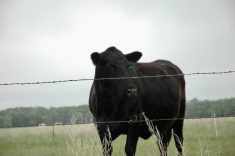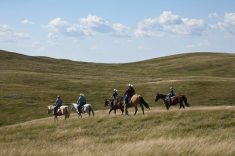Spring on the Prairies is a great time, because the snow has disappeared and pastures are turning green. Whenever I drive past the occasional drylot, I see a lot of beef cows waiting to be released on pasture. It reminds me that with record cattle prices on the board, it might be a time to creep feed spring calves in 2023.
It becomes a matter of assessing the body condition and milking ability of the cow herd and predicting pasture quality throughout the season. Then we can estimate the profits of putting that few extra pounds of saleable weaning weight by autumn and beyond.
Of those who decide to creep their calves, many put out creep feeders during midsummer when decreasing milk production can meet only 50 per cent of a growing calf’s nutrient requirements and pastures are also not as nutritious.
Read Also

Gentle treatments for pain in the neck
Heading toward year-end, people unknowingly tense up against the cold and busyness, causing neck pain that can often be treated with appropriate support and gentle mobility, athletic therapist Kathlyn Hossack says.
Creep feeding calves is a good way to bridge this nutritional gap. The funny thing this year is that early pasture conditions across some parts of Western Canada look good. Plus, most cow herds have come through the winter in good body condition, which contributes to good milk production for their calves.
The combination of good milkers and high-quality pasture (re: often extends throughout most of the summer) may not justify creep feeding. Yet I believe that if we have a normal Prairie summer which is neither particularly wet nor dry; healthy calves will come up and use the feeders. They will start to nose around and pick up about a kilo of creep feed per day. Then during the waning days of summer, creep consumption should take off until weaning with consumption ranging from two to three kilo per head per day (kg/hd/d).

Scenario shows a profit
I have calculated the economics of creep feeding calves for 2023, which targets 60 lbs. of extra weaning weight gain in a 100-day creep-feeding program, compared to calves that are not supplied creep feed. As the accompanying spreadsheet illustrates, there is about a $74 per head profit or about a 100 per cent return on investment (ROI) over feed costs.
Here are some of the major factors that determined a profit of $74 per head:
1. Predicted calf price. Cash and future calf prices estimate that calf prices should top out at about $3.50/lb. Some market reports state that grass and feeder calves are selling at historical highs driven by depressed feedlot placements in the United States.
2. Calf price gradients. There is a sliding price discount as calves hit higher weight classes. In my example, I used a price discount of about $10 cwt. As this price gradient narrows between weight classes, creep feeding becomes more profitable.
3. Feed costs. Tradition says creep feeding is attractive when calf prices are high relative to low feed costs. In 2023, I see that forage and grain prices are both high, but can still yield creep profits when calculated as per my spreadsheet.
4. Feed efficiency. The conversion of a well-balanced creep feed into saleable weaning weight is a major driver in the profitability due to creep feeding. It ranges from 6-8 lb/lb gain for most grain-based creep feeds. For example, for every 0.5 lb FE improvement means an extra $ 5.40 revenue per calf.
Other benefits
Aside from the positive economics of about a 100 per cent return on investment, there are other practical benefits to creep feeding calves. Some producers have told me that their creep-fed calves are not as dependent on the cow by autumn. As a result, calves are much easier to wean with less stress. Other producers say that creep-fed calves are bunk broke, which is a real advantage when put onto subsequent background feeding programs.
However, I spoke with one producer that runs about a 130 cow-calf operation and never considers creep-feeding his spring calves. It’s not that he has anything against creep feeding, but he believes his cows milk well throughout the summer due to his heavily managed rotational pastures. Plus, he grows cover crops in which he pastures both cows and calves on its regrowth from August to late November. As a result, he successfully gets similar performance on his calves’ weaning weights compared to others that are crept fed.
I value what this producer had to say, but I also value the experiences of people that seem to put their creep feeders onto pasture, every year. For them and other cow-calf operators that might consider creep feeding their calves in 2023, the numbers indicate it should be a profitable creep feeding year.
















